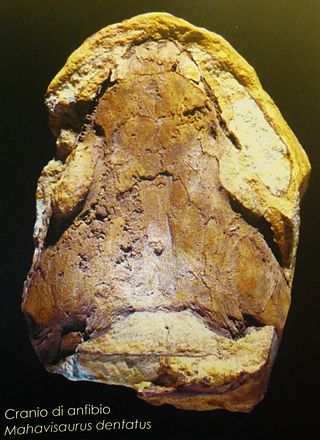
Chiniquodon is an extinct genus of carnivorous cynodonts, which lived during the Late Triassic (Carnian) in South America and Africa. Chiniquodon was closely related to the genus Aleodon, and close to the ancestry of mammals.

Perleidus is an extinct genus of ray-finned fish from the Triassic period. Fossils have been found in the Middle Triassic of Italy, Switzerland, and China. The inclusion of Early Triassic species in the genus Perleidus was questioned.

Hovasaurus is an extinct genus of basal diapsid reptile. It lived in what is now Madagascar during the Late Permian and Early Triassic, being a survivor of the Permian–Triassic extinction event and the paleontologically youngest member of the Tangasauridae. Fossils have been found in the Permian Lower and Triassic Middle Sakamena Formations of the Sakamena Group, where it is amongst the commonest fossils. Its morphology suggests an aquatic ecology.
Asiatoceratodus is an extinct genus of lungfish which lived during the Middle-Late Triassic, Jurassic and Cretaceous periods in what is now Asia (Kyrgyzstan), Africa and South America.
Gonioglyptus is an extinct genus of trematosaurian temnospondyl within the family Trematosauridae. It is known from the Early Triassic Panchet Formation of India. It contains two species: G. longirostris and G. fragilis. The species G. kokeni from Pakistan has since been reclassified into Aphaneramma.
Wellesaurus is an extinct genus of mastodonsauroid temnospondyl. They were amphibious carnivores that lived in freshwater environments.

Mahavisaurus is an extinct genus of rhytidosteid temnospondyl from the early Triassic period of Iraro, Madagascar. It is known from the holotype MNHN MAE 3037, a nearly complete skull, recovered from the Middle Sakamena Formation. This genus was named by J. P. Lehman in 1966, and the type species is Mahavisaurus dentatus.
Tertremoides is an extinct genus of trematosaurian temnospondyl within the family Trematosauridae from Madagascar. It was first named by Lehman, J-P. in 1966 as Trematosaurus madagascariensis but renamed to Tertremoides ambilobensis by Lehman in 1979. Its closest relative was Trematolestes.

Watsonulus is an extinct genus of prehistoric ray-finned fish that lived during the Early Triassic epoch in what is now Madagascar. It may have also existed in what is now Himachal Pradesh, India, during the Induan age. The type species, described by Jean Piveteau, is Watsonia eugnathoides. Because "Watsonia" was preoccupied, the new genus name Watsonulus was later erected. The genus is named after David Meredith Seares Watson.
Lehmanotus is an extinct genus of prehistoric bony fish that lived during the Early Triassic epoch in what is now Madagascar. It belongs to Parasemionotidae together with Albertonia, Candelarialepis, Jacobulus, Parasemionotus, Qingshania, Stensioenotus, Suius, Thomasinotus and Watsonulus. It is named after Jean-Pierre Lehman.

Australosomus is an extinct genus of prehistoric ray-finned fish that lived during the Early Triassic epoch in what is now Greenland, Kenya, Tanzania, Madagascar, South Africa and Canada.
Sakamenichthys is an extinct genus of prehistoric bony fish that lived during the Early Triassic epoch in what is now Madagascar. Fossils were recovered from beds of the Middle Sakamena Formation of the Beroroha basin in the southern part of the island.

Ecrinesomus is an extinct genus of prehistoric bobasatraniiform ray-finned fish that lived during the Induan age of the Early Triassic epoch in what is now Madagascar.

Paracentrophorus is an extinct genus of prehistoric ray-finned fish that lived during the Induan age of the Early Triassic epoch in what is now Madagascar. The type species is Paracentrophorus madagascariensis (monotypy).

Isalorhynchus is an extinct genus of hyperodapedontine rhynchosaur from the late Triassic period of Toliara Province, southwestern Madagascar. It is known from the holotype MDE-R18, a nearly complete maxilla and from other specimens from the same locality, Malio River area. It was found in the Makay Formation of the Morondava Basin. It was first named by Eric Buffetaut in 1983 and the type species is Isalorhynchus genovefae. The majority of Isalorhynchus specimens are isolated jaw bones, but two nearly complete skeletons were found in 1998. Langer et al., 2000 concluded that Isalorhynchus is a synonym of Hyperodapedon and referred it to a new species of Hyperodapedon. Whatley, 2005 retained this genus as valid with a description of new materials in her PhD thesis. Montefeltro et al., 2010 and Langer et al., 2010 accepted Isalorhynchus as valid genus.

Bobasatraniiformes is an extinct order of durophagous ray-finned fish that existed from the late Permian to the Middle Triassic in both marine and freshwater environments. The order includes two families: Bobasatraniidae, with the genera Bobasatrania, Ebenaqua, and Ecrinesomus, and Dorypteridae, comprising only the genus Dorypterus (monotypy). Bobasatraniiformes had a somewhat global distribution; fossils are found in Africa (Madagascar), Asia (Pakistan), Australia, Europe, and North America.

Edingerella is an extinct genus of temnospondyl amphibian from the Early Triassic of Madagascar. It is a basal capitosaur closely related to Watsonisuchus.

Barasaurus is an extinct genus of owenettid procolophonoid parareptile known from the Late Permian and Early Triassic of Madagascar. It contains a single species, Barasaurus besairiei.

Teffichthys is an extinct genus of ray-finned fish from the Early Triassic epoch. Fossils have been found in Madagascar and China, and possibly also in Angola, Canada, Greenland, and Svalbard.

Parasemionotiformes is an extinct order of neopterygian ray-finned fish that existed globally during the Triassic period. It comprises the families Parasemionotidae and Promecosominidae. Many of the included genera are monotypic and most species lived during the Early Triassic epoch.



















